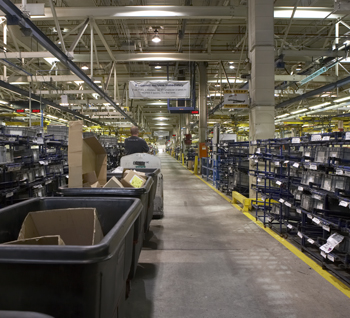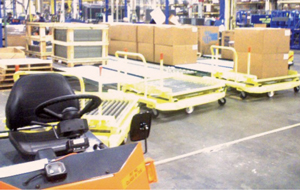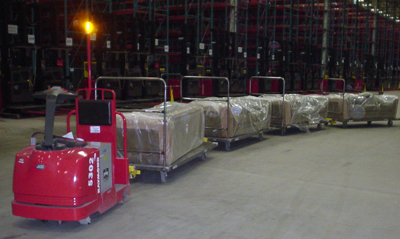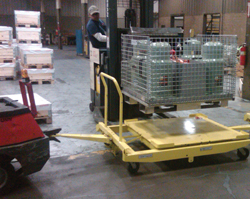Tugger-cart System Is Green Approach to in-plant Material Transport
By Larry Tyler | October 12, 2011
Category:
Sustainability challenges industrial companies to design and produce products and offer services that improve energy efficiency, reduce pollution, and otherwise make operations more ecofriendly.
Green manufacturing is not new. The greening of manufacturing is a direct response to growing environmental awareness over the last 50 years, and specifically in the last 20 years, of increasing water, air, and land pollution all over the world. Most manufacturers believe that green practices can reduce operational costs if implemented correctly and are good for business.
One area manufacturers are scrutinizing for improvement opportunities is in-plant material handling and tugger-cart systems.Forklifts have a long history of being the workhorses of factory floors and warehouses. But manufacturers are re-evaluating their use of forklifts and looking at alternative material handling systems in their plants as they strive to pare energy consumption and increase efficiency.
In fact, the push to embrace methods with green results is prompting some manufacturers to initiate policies to reduce the number of forklifts they employ.
But is it necessary to eliminate all forklifts in the quest to be greener? How can a factory floor be reconfigured to increase productivity and eliminate waste using both forklifts and alternative plant vehicles?
Green Material Handling Logistics
Along with the push to go green is a push to go lean. The terms lean and green overlap quite a bit and are hard to separate. Lean concepts focus on elimination of waste in a process. A lean production initiative may implement a green approach that reduces or removes waste and thereby lessens the negative impact on the environment.
Tugs and carts can contribute to both green and lean agendas by reducing energy use and waste. A balanced approach to material flow incorporates tugs, carts, cart lifts, forklifts, and conveyors.
10 Things to Know About Tuggers and Carts

Figure 1
A tugger turns a corner while pulling a three-roller cart train. Tugs and carts can deliver multiple loads per trip, improving energy efficiency.
Manufacturers should review the following questions and their answers if they are considering converting some of their plant material handling to a tugger and cart operation:
1. Can I save energy by using fewer forklifts and more tugs with carts to move products and materials?
Tugs consume less energy than forklifts because forklifts require two electric motors—one to lift and another to operate the drive—while tugs need only one motor. Most of the energy forklifts consume is while lifting loads.
In addition, because tugs and carts handle more load volume per move, less energy is consumed than by the multiple trips a forklift must make to deliver the same amount of materials (see Figure 1).
2. Does using a tugger and cart system save time?
One tug can pull a train of several carts across the production floor. The tug stops at each station to deliver materials and collects empty carts or containers for a total of one complete run.
This reduces wait times in production. Assembly operators do not have to wait until a forklift is available to move products into a workcell or to the parts area. Carts can be moved by hand as well.
3. What type of training is required to operate tuggers and carts?
Tugger controls are simple, and tugger operation requires only basic, non-certified operator training.
4. How can I use factory space most efficiently?
An approach that combines tuggers with carts and forklifts can eliminate congestion and bottlenecks on the factory floor. Redesigning routes to create dedicated paths for carts and tugs, forklifts, and people can reduce traffic in heavily traveled areas to improve material flow (see Figure 2).
Improved material flow can reduce inventory at workstations and increase worker productivity. If a workcell has more than four hours’ worth of parts or assemblies inventory, that usually means the forklift driver has “buffered” his route with material that should be in the parts area.
5. We have been using forklifts since our plant opened. Can I eliminate all forklifts?
You will not be able to eliminate all forklifts. However, forklift usage can be limited to appropriate zones like shipping and receiving and to the perimeter of the factory floor.
6. How long of a train can the tugger pull?
The length of the train depends on aisle widths, plant size, size and type of carts, tug capacity, and safety regulations in the plant. For deliveries in assembly plants, trains of two or three carts are typical. If properly sequenced in a last-in, first-out order, longer trains of six to eight carts can be assembled, provided the tug has adequate capacity, the aisles are large enough, and cart steering is modified to handle turning (see Figure 3). In warehouses, trains are often six to eight units long, especially when carts are used just to transport material to and from the dock or sorting and put-away locations.

Figure 3
If properly sequenced in a last-in, first-out order, trains of six to eight carts can be assembled, provided the tug has adequate capacity, the aisles are large enough, and cart steering can handle turning.
7. What variables determine which types of carts and configurations to use?
The type of cart that you choose depends on the weight, size, and shape of your product and load, plant configuration, and whether sequencing is involved (see Figure 4).
8. My picker operator has to load material from 10 to 15 feet in the air, which is a safety concern. Can I use a tug and cart system instead?
No, you really cannot use a cart and tugger for vertical stacking. Another type of vertical material handling equipment, such as order pickers, reach trucks, or turret-style trucks, might be a safer alternative for loading at those heights.
9. Are tuggers and carts restricted to use in the plant only?
No, a tugger and cart system can also be used to transport product between the plant and warehouse (see Figure 5).
10. If I incorporate tugs and carts, will other areas of the operation be affected?
All areas of your plant will be affected. For this reason, it is important to include plant personnel in the planning process.
Early Planning Yields Best Results
Early planning is key to project success. Steps should include writing goals; analyzing the current situation, possibly using simulation to test assumptions and verify an approach; and identifying potential for improvement. If your project is large overall, you may want to address it in increments because process changes mean changes in the way people work, and that means changing habits as well. Initial successes may make subsequent steps easier.
The most effective green and lean material handling results will be obtained by using these tools where they make the most sense rather than reverting to old habits. Tug and cart applications that also save energy and contribute to greener manufacturing are a double win.
HVAC Manufacturer Balances Tugs and Forklifts

Figure 6
A rotational deck cart is being loaded with compressors for delivery to assembly.
A large manufacturer of commercial HVAC systems placed its bulk components for installation on industrial carts staged in the line at each workcell (see Figure 6). This allowed the operators to easily retrieve their next unit using an overhead jib boom and manually rotate the deck to allow easy access to the large dunnage from one side.
Previously full dunnage was dropped and empties retrieved by forklifts. This created an unsafe situation for assemblers, who were often standing in the narrow aisles where forklift operators were maneuvering the loads.
Other Approaches
Several manufacturers are implementing material handling strategies known as “mother/daughter” (M/D) cart delivery systems to improve their operations (see Figure 7).
The M/D cart delivery system typically has two small carts within a larger cart. Bulk parts can be manually or forklift-loaded onto the two daughter carts in the stock or storage area. One or two complete M/D frames can be towed by a tugger to line-side positions and “dropped” for the assemblers to use, or daughter carts are removed and positioned for use in the cells.
The M/D approach simplifies delivery. It allows the daughter carts to be unloaded without disconnecting carts in a train and permits the selection of any daughter cart in the mother train without regard for sequence position, simplifying loading for delivery.

Side by side, we move metal fabrication forward.
FMA unites thousands of metal fabrication and manufacturing professionals around a common purpose: to shape the future of our industry, and in turn shape the world.
Learn More About FMA


